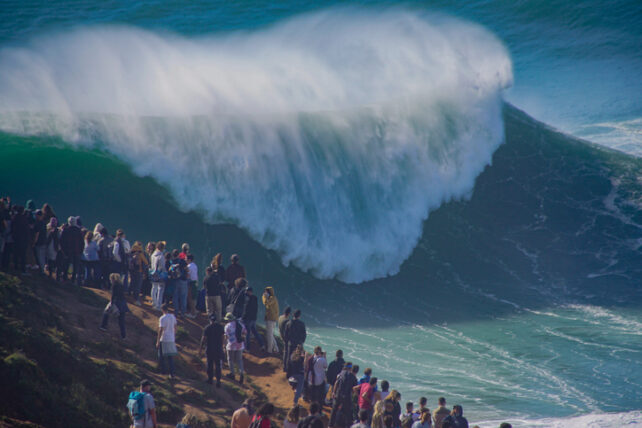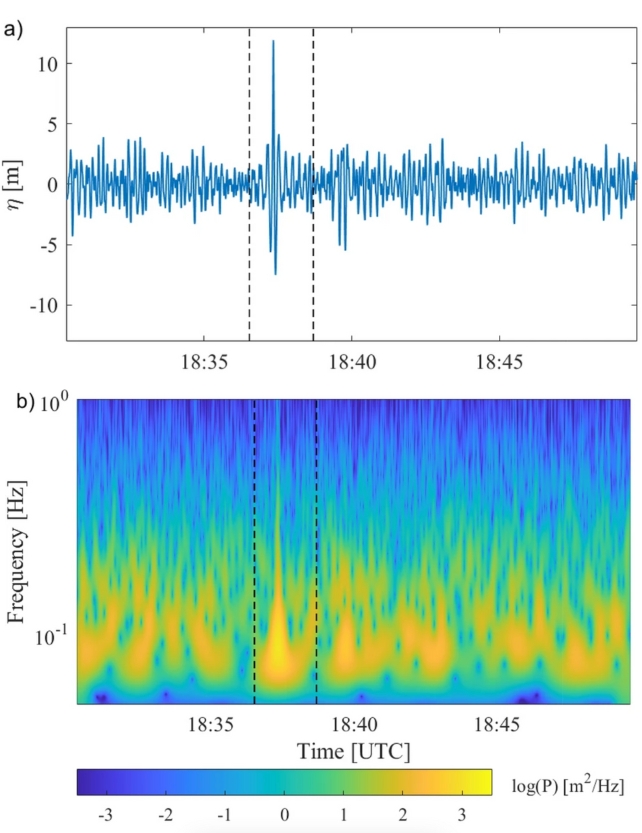Rogue waves can reach heights of over 100 feet 😳pic.twitter.com/l1JDvyfnt7
— UberFacts (@UberFacts) March 24, 2023
Rogue waves can reach heights of over 100 feet
From Science Alert by Carly Cassella
In November of 2020, a freak wave came out of the blue, lifting a lonesome buoy off the coast of British Columbia 17.6 meters high (58 feet).
The four-story wall of water was finally confirmed in February 2022 as the most extreme rogue wave ever recorded at the time.
Such an exceptional event is thought to occur only once every 1,300 years.
And unless the buoy had been taken for a ride, we might never have known it even happened.
11. The size of these waves are incredible! It takes some balls to do these jobs! Massive respect ✊pic.twitter.com/qIEoecr3L8
— Vertigo_Warrior (@VertigoWarrior) January 15, 2025
For centuries, rogue waves were considered nothing but nautical folklore.
It wasn't until 1995 that myth became fact.
On the first day of the new year, a nearly 26-meter-high wave (85 feet) suddenly struck an oil-drilling platform roughly 160 kilometers (100 miles) off the coast of Norway.
 Large wave in Nazaré, Portugal, where the record was set for the biggest wave ever surfed in 2017. (Alexander Ehlers/Getty Images Plus)
Large wave in Nazaré, Portugal, where the record was set for the biggest wave ever surfed in 2017. (Alexander Ehlers/Getty Images Plus)At the time, the so-called Draupner wave defied all previous models scientists had put together.
Since then, dozens more rogue waves have been recorded (some even in lakes), and while the one that surfaced near Ucluelet, Vancouver Island was not the tallest, its relative size compared to the waves around it was unprecedented.
Video reconstruction of the »New Years Wave«, from BBC documentary.
The »New Years Wave« or »Draupner Wave« was a Monster wave in the North Sea 1995.
The Oil Rig is the Draupner Oil Rig, run by Strato.
This one is appr. 30m high.
Scientists define a rogue wave as any wave more than twice the height of the waves surrounding it.
The Draupner wave, for instance, was 25.6 meters tall, while its neighbors were only 12 meters tall.
In comparison, the Ucluelet wave was nearly three times the size of its peers.
"Proportionally, the Ucluelet wave is likely the most extreme rogue wave ever recorded," explained physicist Johannes Gemmrich from the University of Victoria in 2022.
"Only a few rogue waves in high sea states have been observed directly, and nothing of this magnitude."
Today, researchers are still trying to figure out how rogue waves are formed so we can better predict when they will arise.
In comparison, the Ucluelet wave was nearly three times the size of its peers.
"Proportionally, the Ucluelet wave is likely the most extreme rogue wave ever recorded," explained physicist Johannes Gemmrich from the University of Victoria in 2022.
"Only a few rogue waves in high sea states have been observed directly, and nothing of this magnitude."
Today, researchers are still trying to figure out how rogue waves are formed so we can better predict when they will arise.
This includes measuring rogue waves in real time and also running models on the way they get whipped
up by the wind.

Rogue wave recorded on Nov 17, 2020. Vertical dashed lines indicate the wave group containing the rogue wave.
(a) Surface elevation.
(b) Spectrogram of surface elevation using the Morlet wavelet.
(Gemmrich & Cicon, Scientific Reports, 2022)
The buoy that picked up the Ucluelet wave was placed offshore along with dozens of others by a research institute called MarineLabs in an attempt to learn more about hazards out in the deep.
10. Offshore oil rig in the middle of a sea stormpic.twitter.com/Jke8BnrNQa
— Vertigo_Warrior (@VertigoWarrior) January 15, 2025
Even when freak waves occur far offshore, they can still destroy marine operations, wind farms, or oil rigs.
If they are big enough, they can even put the lives of beachgoers at risk.
Luckily, neither Ucluelet nor Draupner caused any severe damage or took any lives, but other rogue waves have.
Luckily, neither Ucluelet nor Draupner caused any severe damage or took any lives, but other rogue waves have.
A team of researchers at the Universities of Oxford and Edinburgh have worked out how freak waves can happen.
The research was led by Dr Mark McAllister and Prof Ton van den Bremer at the University of Oxford, in collaboration with Dr Sam Draycott at the University of Edinburgh.
This project builds upon work previously carried out at the University of Oxford by Professors Thomas Adcock and Paul Taylor.
The experiments were carried out in the FloWave Ocean Energy Research facility at the University Of Edinburgh.
The leftover floating wreckage looks like the work of an immense white cap.
Unfortunately, a 2020 study predicted wave heights in the North Pacific are going to increase with climate change, which suggests the Ucluelet wave may not hold its record for as long as our current predictions suggest.
Unfortunately, a 2020 study predicted wave heights in the North Pacific are going to increase with climate change, which suggests the Ucluelet wave may not hold its record for as long as our current predictions suggest.
A simulation of the MarineLabs buoy riding a rogue wave off the coast of Ucluelet, Vancouver Island
in November, 2020
in November, 2020
Experimental research published last year suggests these monstrous waves can be up to four times higher than previously thought possible.
"We are aiming to improve safety and decision-making for marine operations and coastal communities through widespread measurement of the world's coastlines," said MarineLabs CEO Scott Beatty.
"Capturing this once-in-a-millennium wave, right in our backyard, is a thrilling indicator of the power of coastal intelligence to transform marine safety."
"We are aiming to improve safety and decision-making for marine operations and coastal communities through widespread measurement of the world's coastlines," said MarineLabs CEO Scott Beatty.
"Capturing this once-in-a-millennium wave, right in our backyard, is a thrilling indicator of the power of coastal intelligence to transform marine safety."
Links :
- The study was published in Scientific Reports
- Newswire : Record-Breaking Rogue Wave Recorded off the Coast of Vancouver Island
- Earth : Most extreme "rogue wave" ever recorded in the Pacific Ocean detailed in new study
- ResearchGate : The physics of anomalous ('rogue') ocean waves
- Tudelft : Unusual waves grow way beyond known limits
- QuantaMag : What Causes Giant Rogue Waves?
- The Conversation : How scientists recreated a monster wave that looks like Hokusai’s famous image
- GeoGarage blog : Rogue waves in the ocean are much more common than ... / Enormous 'rogue waves' can appear out of nowhere. Math ... / Terrifying 20m-tall 'rogue waves' are actually real / Study finds massive rogue waves aren't as rare ... / Oxford scientists successfully recreated a famous rogue ... / How rogue waves are created in the ocean / Theories of giant waves that suddenly appear and vanish / Four-story high rogue wave breaks records off the coast of ... / How dangerous can ocean waves get? Wave comparison / Rogue wave theory to save ships / Rogue waves captured / The Bermuda Triangle: A breeding ground for rogue waves ... / 19-meter wave sets new record - highest significant ... / The Power of the SEA: tsunamis, storm surges, rogue ... / NZ tech could reveal planet's largest waves / Rough seas for tough mariners
No comments:
Post a Comment